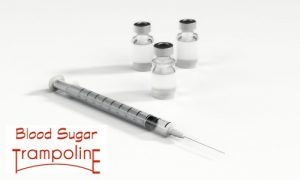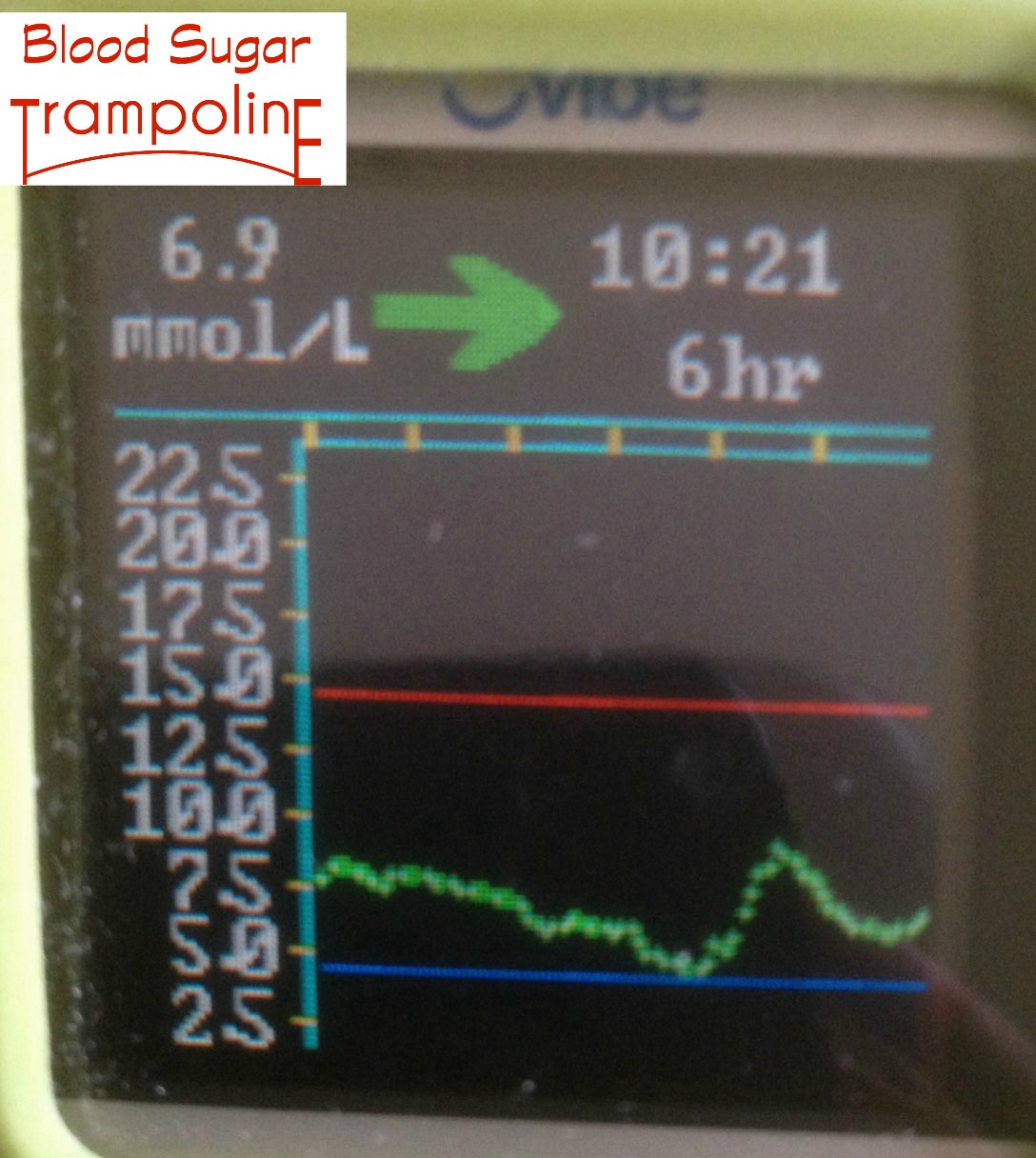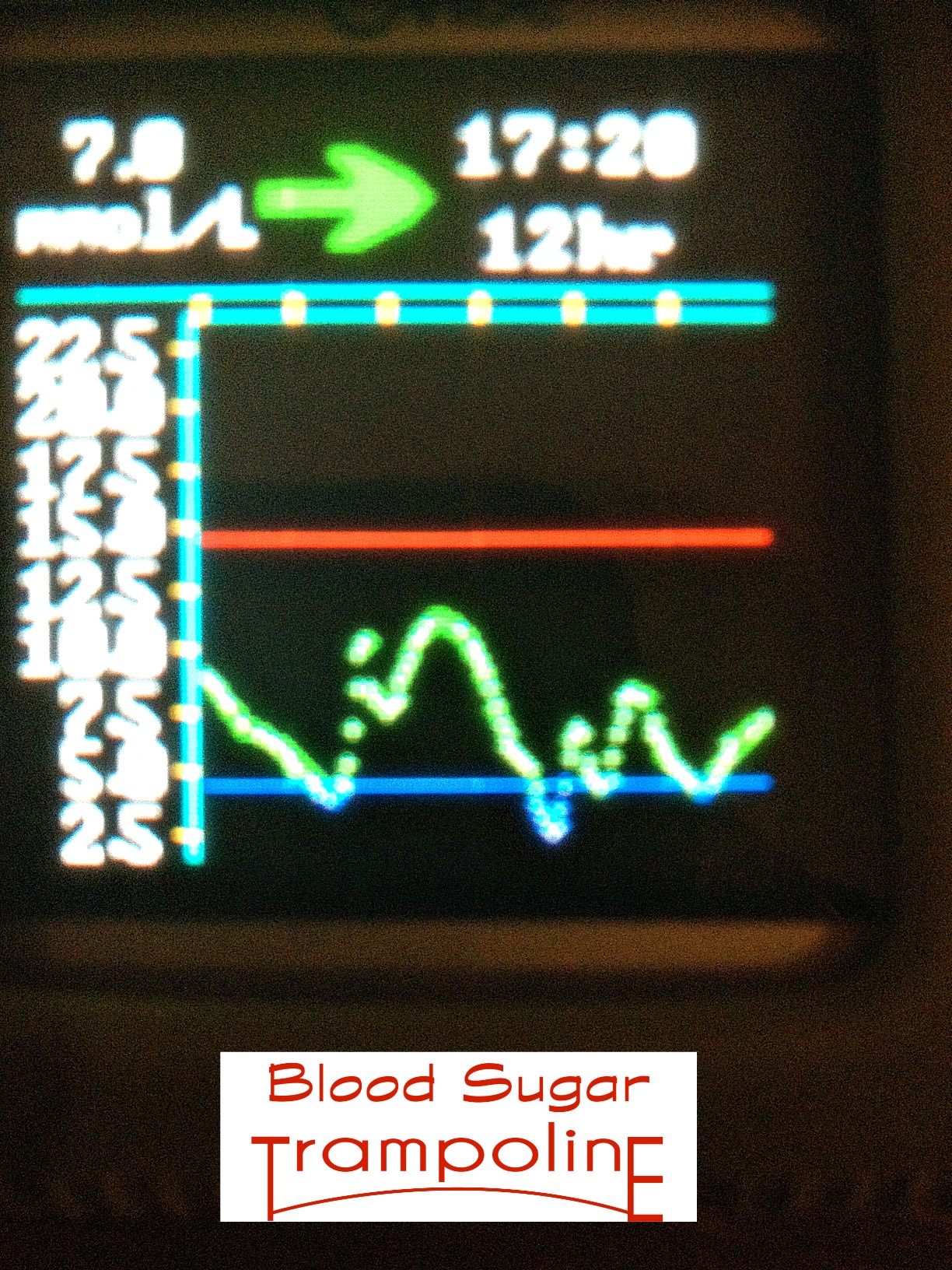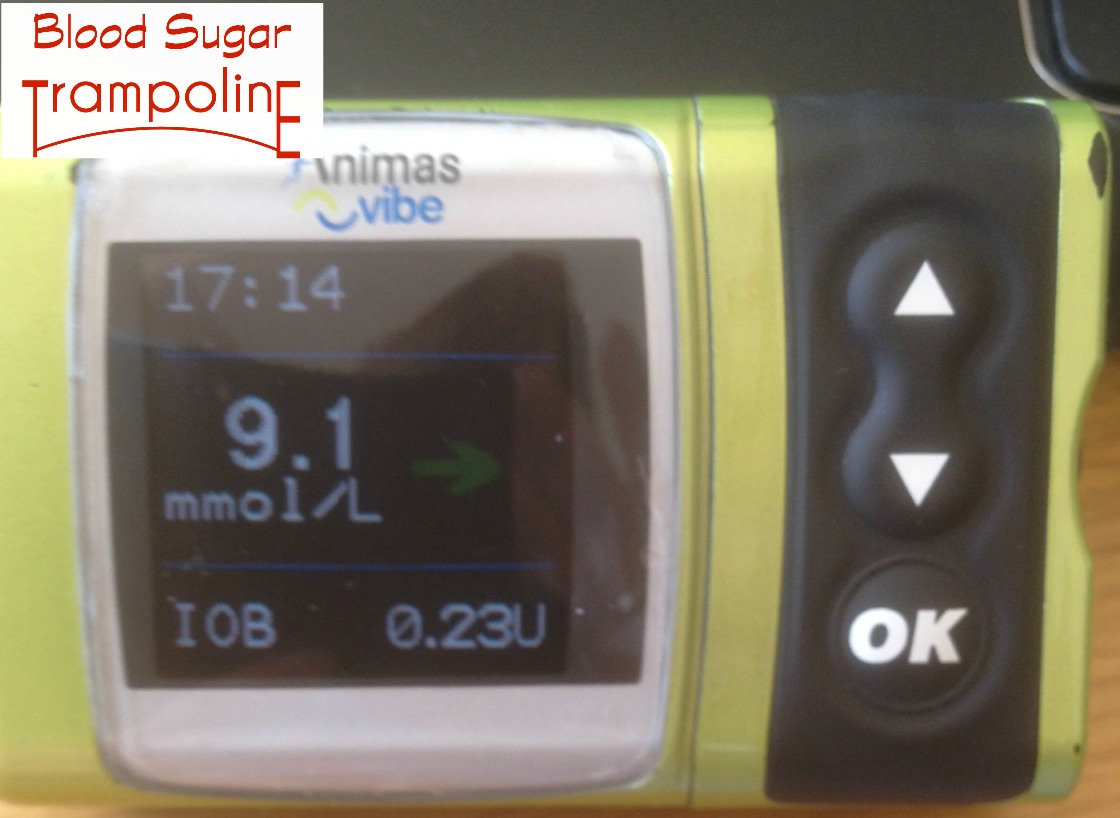Has anyone noticed their blood sugar/glucose numbers dropping lately as the Spring temperatures tease us? Welcome to Spring, where it’s hot, it's cold, it's summer one day and winter the next.
The Hard Diabetes Changes
I've been using an insulin pump for almost seven years and it's unlikely that I will go back to injection pens. However, I know that things change over time and how I feel about things also change, so I will never say that I will never go back to injection pens because the future is unpredictable.
This week, I have been thinking a lot about all the times I've changed the way I manage my diabetes and how difficult some of those changes were. 
I remember when I was transitioning from pens to my pump and that period where I was “practicing” with it. I swear I just wanted to throw it against a wall it was so annoying. But I was also doing twice the work; I was injecting the real insulin with my pens and calculating pretend insulin doses with saline in the pump. It took twice the time for no extra gain. I did that for three days.
I sat in my kitchen one of those three days and thought to myself what if, after all I went through to get this pump, I actually hate it? What if it drives me batty? Why am I changing everything? And the horrifying thought of what if it doesn't help me?
Then I reminded myself that very few people around the world give their pumps back - they continue to use them and are happy with it. I had seen this research on the internet. I also reminded myself that if I didn't like it that I could go back to pens. I reminded myself that change is always hard.
I remember when, after living with type 1 diabetes for 6 years, I changed from two injections per day to four! I remember thinking "how is this better?" when it was suggested. I didn't want to do it but my research told me it was a better way and it was worth trying.But it was better.

I remember when my first blood glucose meter became obsolete. I think I used it for 5 years!!! I know, it was crazy! It was a pain to try a new one. Not to mention changing to new test strips. But it was a good change.
I remember when I went from checking my blood glucose twice per day to four and then to seven. That was a pain but, again, worth it. I learned so much about managing my insulin doses to match the needs of my body from all of those tests. Now, it's simply out of habit that I still maintain those 7 tests.
I remember when I tackled proper carb counting and not just guessing - that was a lot of extra work for a couple of weeks. Again worth it.
I was not happy with the results I was getting in my life with diabetes and even though change is always going to be difficult at first, it’s worth remembering that some changes are worth it. Some were not worth the effort and I didn’t continue with them. But doing nothing was not an option. If I didn't try I would never know if it was better.
Empowerment and Diabetes - My Journey
Last May, I was asked by the organisers of the Future Health Summit to give a presentation on how I became an empowered person with diabetes. Some friends asked if I could blog about it. The reason for my topic choice was because the theme of the conference was Empowering the Patient, Information, Choice & Accountability and I decided to focus on Empowering the Patient element for my presentation. I feel like I am one, that diabetes does not have power over me, I have a lot of power over it.
The journey towards being an empowered patient didn’t happen overnight, for me. I would like to think that a person with diabetes diagnosed today would find empowerment much quicker than I did. But the two core elements that were pivotal in my journey didn’t really exist when I was diagnosed. Those elements were Diabetes Education & Support.
Obviously my Journey Began with diagnosis 23 years ago - 1993. Diabetes Education was extremely basic in Ireland back then, if it existed at all!
My diabetes management involved;
Injecting a fixed amount of insulin twice every day
Eating the same amount of food at the same time every day
Checking Blood Glucose levels just twice every day
And I was taught How to recognise & treat a hypo
For those first 6 years I felt like I blindly coasted through my diabetes care. I did what I was asked to but I had no idea why I was doing any of it, except to stay alive.
So what changed? What prompted me to get on the bus to empowerment?
This is going to sound corny but it was love. In 1999, I met this bloke.
Phil
This is Phil. We weren’t going out very long but he already had notions about our relationship and we weren’t going out for very long when he asked me for books or leaflets where he could learn more about helping me manage my diabetes. I was stunned! And for three reasons;
He was the first person I met who didn’t expect me to educate him on something I barely knew myself.
That the relationship was moving a bit faster than I had thought and
that I had nothing, absolutely nothing to give him when it came to information.
What I did have was access to the internet at work. So the next day, during my lunch break, I “AltaVista’d” type 1 diabetes. If you don’t know what AltaVista is, google it! :-D
I couldn’t believe what I found - the list of websites containing information was so long. I found all of these organisations with websites that had tonnes of practical information such as the Joslin Diabetes Centre and the world’s leading research organisation, the JRDF. I had never heard of these places before.
I started reading all of this information before handing it over to Phil and it got me thinking that there might be a better way to live with diabetes. But that thinking got shelved for a while as this journey is not an express route and it required a couple of transfers to reach my destination.
1st Transfer–Diabetes Education
You’ll be happy to know that I, very quickly, realised Phil was a keeper and by 2003, we had been married a couple of years, had moved to US and we were thinking about starting a family. As soon as my endocrinologist heard this he marched me off to a dietitian to learn about counting carbohydrates, insulin dose adjustment and sliding scales.
I had been diagnosed 10 years by the time I found diabetes education which now seems too long. But this knowledge gave me some of the control over this thing called diabetes for the first time. And I felt supported; supported by my diabetes team and supported with knowledge. I didn’t realised it then but my diabetes team in the US was the first I experience of patient centred care.
Family 1
family 2
2nd Transfer–Diabetes Peer Support
The 2nd transfer on my journey towards empowerment was finding peer support.
By 2007, we had moved back to Ireland, had our second baby and I was increasingly frustrated and unhappy with the diabetes care I was receiving. In June of that year I found myself at my lowest point after leaving the most humiliating diabetes appointment I’ve ever experienced. But it propelled me into action. I knew there had to be someone out there who would make me feel listened to.
I went home and remembered a recent newspaper article about a new branch of Diabetes Ireland being set up in Clare. I called the number in the piece and the lady who answered was a fellow person with type 1 diabetes. What are the odds? She had had her second baby around the same time as I had and we were both new to Clare. We instantly connected and during the course of that conversation we realised that we both wanted to meet more people like us and to do this was to set up diabetes support groups.
By the end of 2007, we had diabetes support groups and they continue to be a source of information, motivation and inspiration for me. And they, with some information from Diabetes Ireland helped me find a diabetes team that works amazing for me.
support group
Destination Reached - Person Empowered
This is where I feel my journey towards empowerment was completed. I had reached my destination.
Yes, I took the scenic route to being an empowered person with diabetes. An empowered person with diabetes who can drive her own diabetes. And I became that by finding two very simple, very basic diabetes resources but yet they are not accessible to everyone with diabetes in Ireland.
The first necessity is Diabetes education is as important as giving someone who wants to drive a car lesson and some theory. Would you really put a beginner in the driving seat of a car without it? And not just structured diabetes Education, like the university style of lectures. This education has to be an ongoing 2-way conversational style of learning, where a person with diabetes can grow in confidence, drive their own diabetes and the instructor takes more of a back seat each time.
The second is Diabetes Support and for me that comes from three sources;
At home - I may be the person with diabetes but my whole family lives with it. The more supported I am at home the more successful I will be in my diabetes management.
My Diabetes team - My journey has taught me that I need a health care team who listens to me, acknowledges all that I do to manage my care and doesn’t just focus my failings. A team that continues to teach me and a team that continues to learn.
My diabetes Peers – the most undervalued, underused resource available for people with diabetes today. Who else knows what it’s like to live with diabetes than other people with it. We learn so much from sharing our experiences, so much that can’t be taught in a hospital appointment.
So while my journey towards empowerment has been completed, my life with diabetes journey still continues. And I hope to continue that journey for many, many decades.
Diabetes gone Wild on Holiday
It's summer, which means for a lot of people it's holiday time. “They” say that diabetes never takes a holiday but what “they” don’t tell you is that when you take a holiday you should be warned that your diabetes will behave as if it’s gone wild in Ibiza and partying like it’s 1999. I took a holiday for the last couple of weeks. I didn’t go anywhere though. My brother in law and his family were visiting from America, hubby took ten days off work and the kids are on their summer break, so I decided it was a good idea to take a break too. No emails, no posting, very little facebook and twitter (let’s be honest - zero facebook while FFL was going on in Florida was just out of the question:-)
We did lots of day trips, lots of sightseeing, lots of driving, lots of eating out and almost no downtime. One day there could be lots of walking, the next was lots of time in the car. This is my diabetes worst nightmare!

My high and low blood glucose alarms went off a lot! Food that I thought might be low carb turned out not to be. Trying to schedule bathroom breaks around optimal blood glucose checking times was challenging. It was all exhausting. My diabetes broke all of the rules, even the ones that I had it well trained in. It decided that all bets were off.
For the biggest part, the holiday was soo much fun with fun people. But I’m ever so glad to be chillin’ at home with the kids for the rest of the summer.
Things I've Learned about My Diabetes with a CGM
I have been using a Continuous Glucose Monitoring device (CGM) for six months and I feel that I have enough information now to share what I have learned about my diabetes management in those short months. A couple of weeks ago I shared how I came to get my hands on this little golden nugget and you can read about that here.
So here it goes, in no particular order, what I have learned.
Rapid acting insulin is not that rapid at all!
If my blood sugar levels dare to go ⇑ and beyond, it could take up to 4 - 6 hours for the insulin to bring them back to normal. It is a major exercise in patience!!! And can lead to rage bolusing (i.e. getting extremely frustrated and bolusing more that reason dictates).
Before CGM, I would take a correction dose of insulin, go to bed, only to wake up in the morning to realise that it hadn’t lowered my levels as much as I had hoped and I had spent at least 8 hours with elevated blood glucoses levels.

Hypo treatments don’t work fast either.
Glucose, even in its purest, most rapid form doesn't work fast enough. This can lead to over treating but thankfully the CGM can help curb the overtreatment.
Angle of Arrow Interpretation ⇑⇒⇓⇖⇗⇘⇙
Interpreting what the angle of the arrow next to my blood glucose reading, means in terms of where my blood sugar levels are heading is not that easy but after a bit of trial and error can be achieved.
The alarms can be annoying.
The alarms! The alarms, in the beginning, were, can be annoying and did interrupt many nights of sleep. But they are there for a reason. And very good reasons at that.
The alarms are very useful learning tools.
I tried not to get frustrated with the alarms, especially the low glucose one, which I have set at 4.4mmols. This give me enough time to prevent an actual hypo and I’m still rational enough to decide how to deal with the impending train wreck.
Mostly I use the alarm as learning tool on how to adjust my insulin dose to avoid them. And it’s worked. Six months ago my high blood glucose alarm was set at 16.6 and now I’ve gradually brought that down to 13.3, it only very occasionally goes off (touch wood). They are especially helpful for dealing with days out of my routine and for food that I don’t have very often.
I’m self conscious about my gadgets and gizmos.
Since the weather warmed up I’ve been wearing short sleeves and my sensor, which is placed on my upper arm, attracts a bit of attention. This does make me think about wardrobe choices a bit more and if I really want to talk diabetes.
I sleep less.
This is both good and bad. Bad because I might be woken several times a night because of the alarms and good because I know that I will never have a hypo again without being aware of it. Sleeping through hypos was a huge concern of mine and the reassurance that my CGM gives me is invaluable.
Sometimes my CGM is not reliable.
Just like any other piece of technology I have noticed that there are times where I should double check my CGM reading with a finger prick check. The times this most often happens is usually the first day of a new sensor and when my blood glucose levels are rising quickly or falling quickly. So I still do 7 finger prick tests a day.
My blood glucose levels are within their targets 65% of the time.
Finger prick blood glucose tests give you a snapshot of where your levels are at that point. The CGM tells you where your blood glucose levels are ALL of the time. It’s the difference between having a photo or seeing the whole movie/book. Now that I have a starting point I can try to increase that percentage and spend more time within a healthier blood glucose range. I also appreciate knowing that number is over 50%.
My CGM does influence my behaviour.
That little graph display does influence my behaviour around food and it also helps me stem the spike in my post meal blood glucose levels. It influences decisions about my treats, such as helping me determine should I choose a full bar of chocolate, just 2 squares of the good dark stuff or on warm sunny days the ice cream. My cgm really helps me spend more time within my blood glucose target range.
It has helped reduce my HbA1c!!!
Yes! I had my lab work done at the end of May and I have had the lowest HbA1c that I have had in four years and the time before that I maintained close to this level while I was pregnant with my first child 12 years ago. I have not been able to stabilize this level at any other time. I have been using an insulin pump for 6 years and hadn’t achieved a lower number. Insulin pumps should be available to those who want them and it should be very much about a personal choice. But CGM’s, in my opinion, are way more valuable a tool for managing diabetes and should be strongly encouraged. Even if it’s just for a couple of months. I know they are expensive but in the long run they would reduce the number of hospital admissions for both hyper and hypoglycemia.
All in all, I am never giving this device up! Knowing where my blood sugars are at any given time has been so reassuring and relieved so much anxiety.
On a promotional note, I attended a presentation by Thriveabetes 2016 keynote speaker, Gary Scheiner on "Making the Most of Your CGM" where I learned lots of useful information and he has published a book on it, "Practical CGM". You can register for Thriveabetes 2016 here.
How I got a CGM
The end of May marked six months since I got CGM'd. WOW! It just flew by.

After two years of persistence, I finally got my CGM on November 27th 2015. When I announced this on social media I has a number of queries about how I managed to get approved and how difficult others were finding their quest.
As always, the one thing that the diabetes community is brilliant at, is sharing knowledge through our personal experiences for the benefit of others. So, here is the story of how I came to have a CGM.
How did this quest begin? Well, it began with an insulin pump (and that was another long drawn out "quest") in June 2010. I wrote about that journey here on 29th March 2011.
I use the Animas Insulin Pump and as soon as Animas announced that they were rolling out the Animas Vibe with CGM integration in the UK and Ireland, I was on it like sticky on a toddler.
My pump was due for an upgrade in 2014 as the warranty runs out at 4 years and because the pump software would not continue past January 2016. I called my Animas rep to find out how, or if there was a chance that I would get a Vibe as part of this upgrade and she said yes! Great! But wait!
Hiccup no. 1. However, between hearing this information and my next appointment at my endo's office, my Animas rep, the only Animas employee in Ireland at that time, took a 12 month sabbatical. That combined with having only 3 visits per year to my endo doesn’t give me much of a chance to get things done. I did get my Vibe in June 2014 and immediately started chasing down how to get the CGM component.
Hiccup no. 2. My Animas rep returned from her sabbatical the following August BUT then my fabulous endocrinologist left her position at the hospital I attend! I decided to use this opportunity to migrate back into public health care for my diabetes. My children were both in primary school and it was doable to fit clinic visits during school hours. I had also heard of a clinic that was only a one hour drive away that had an insulin pump clinic and DAFNE.

Hiccup no. 3. Fifteen month waiting list!!!!!!!!!!!!!!!! Not kidding! By the time I got my referral sorted out to my new clinic and waited I had been without medical care for 11 months. I was doing fine but I was starting to get a wee bit unsettled. Thankfully, when I called to chase up my referral they squeezed me into the Type 2 diabetes clinic in April 2015 but at least I was in and on the books.
June 2015 - I set up a trial before purchase with a Dexcom CGM for two weeks and I was hooked. And now I had data, with the help of my mathematical husband, to strengthen my case for getting one permanently.
October 2015 - I presented my case and there were a couple of breakdowns in communication but the paperwork was put through to apply for funding approval from the HSE and on the 27th November I was live on a CGM permanently.
It took 17 months to complete this quest, that in the end when I had convinced my diabetes team why I wanted one took 6 weeks. Unlike an insulin pump, the training and education required before a patient goes live on a CGM is minimum.
In February 2016, an additional piece of this quest was completed and that was the reimbursement of the monthly supply of sensors which comes not from the Core List F of diabetes supplies and medications included in the Long Term Illness Scheme but on the Special Product List. See here for more information.
And that is the complicated story of how I got a CGM. My next post will focus on what I have learn about managing my diabetes by using it and how I will be taking it to the grave with me.
If you want to find out more about what is a CGM (Continuous Glucose Monitoring) device is, watch here. There are two available in Ireland at the moment; the aforementioned Dexcom (with or without the Vibe insulin pump) and the Medtronic RealTime Guardian CGM. The newer Medtronic pumps all come with CGM compatibility but you can get the CGM component without getting an insulin pump.










